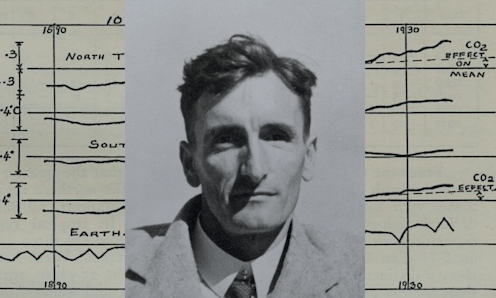
In 1938, a British engineer and amateur meteorologist made a discovery that set off a fierce debate about climate change.
Scientists had known for decades that carbon dioxide could trap heat and warm the planet. But Guy Callendar was the first to connect human activities to global warming.
He showed that land temperatures had increased over the previous half-century, and he theorized that people were unwittingly raising Earth’s temperature by burning fossil fuels in furnaces, factories and even his beloved motorcycles.
When Callendar published his findings, it set off a firestorm. The scientific establishment saw him as an outsider and a bit of a meddling gentleman scientist. But, he was right.
His theory became widely known as “the Callendar Effect.” Today, it’s known as global warming. Callendar defended his theory until his death in 1964, increasingly bewildered that the science met such resistance from those who did not understand it.
Building on over a century of climate science
A theoretical basis for climate change had been developed over the 114 years leading up to Callendar’s research.
Scientists including Joseph Fourier, Eunice Foote, John Tyndall and Svante Arrhenius had developed an understanding of how water vapor in the Earth’s atmosphere trapped heat, noted that carbon dioxide in the atmosphere also absorbed large quantities of heat and speculated about how increasing fossil fuel use could raise Earth’s temperature and change the climate.
However, these scientists spoke only of future possibilities. Callendar showed global warming was already happening.

A page from Guy Callendar’s 1938 paper shows how he tracked and calculated CO2 changes, all in his spare time.
GS Callendar, 1938
An engineer runs his own climate experiments
Callendar received a certificate in mechanics and mathematics from City and Guilds College, London, in 1922 and went to work for his father, a well-known British physicist. The two shared interests in physics, motorcycles, racing and meteorology.
Callendar would later join the U.K. Ministry of Supply in armament research during World War II and continued to conduct war-related research at Langhurst, a secret research facility, after the war.
But his climate change work was done on his own time. Callendar kept journals with detailed weather data, including carbon dioxide levels and temperature. In an innovative paper published in 1938, he claimed there was an “increase in mean temperature, due to the artificial production of carbon dioxide.”
He averaged diverse sets of temperature data from all over the world, primarily using the Smithsonian publication “World Weather Records,” and derived global average temperatures that track very well with current estimates of the average temperatures of the time.
 Ed Hawkins/Twitter
He also calculated how much carbon dioxide humans were putting into the atmosphere – the annual net human addition. In 1938, it was about 4.3 billion tons, which compares well with current estimates for that year of about 4.2 billion tons. Note that global carbon dioxide emissions in 2018 were about 36 billion tons.
Gathering published data on carbon dioxide levels in the atmosphere, Callendar created a graph correlating temperature increases over time with increases in atmospheric carbon dioxide levels.
What Callendar discovered
Perhaps most importantly, Callendar recognized that new data on the heat absorption of carbon dioxide at wavelengths different from that of water vapor meant that adding carbon dioxide would trap more heat than water vapor alone.
In the period before Callendar’s paper, key scientists thought the huge volume of water vapor in the atmosphere, one of the “greenhouse” gases that keep Earth warm, would dwarf any contribution by carbon dioxide to Earth’s heat balance. However, heat is radiated out to space as waves, with a range of wavelengths, and water vapor absorbs only some of those wavelengths. Callendar knew that recent, more precise absorption data showed that carbon dioxide absorbed heat at wavelengths that water missed.
Ed Hawkins/Twitter
He also calculated how much carbon dioxide humans were putting into the atmosphere – the annual net human addition. In 1938, it was about 4.3 billion tons, which compares well with current estimates for that year of about 4.2 billion tons. Note that global carbon dioxide emissions in 2018 were about 36 billion tons.
Gathering published data on carbon dioxide levels in the atmosphere, Callendar created a graph correlating temperature increases over time with increases in atmospheric carbon dioxide levels.
What Callendar discovered
Perhaps most importantly, Callendar recognized that new data on the heat absorption of carbon dioxide at wavelengths different from that of water vapor meant that adding carbon dioxide would trap more heat than water vapor alone.
In the period before Callendar’s paper, key scientists thought the huge volume of water vapor in the atmosphere, one of the “greenhouse” gases that keep Earth warm, would dwarf any contribution by carbon dioxide to Earth’s heat balance. However, heat is radiated out to space as waves, with a range of wavelengths, and water vapor absorbs only some of those wavelengths. Callendar knew that recent, more precise absorption data showed that carbon dioxide absorbed heat at wavelengths that water missed.
 Guy Stewart Callendar in 1934.
G.S. Callendar Archive, University of East Anglia
Callendar also considered different layers in the atmosphere. Carbon dioxide concentrates at a higher altitude in the atmosphere than water vapor. Atmospheric water vapor evaporates and then precipitates out of the atmosphere as rain or snow, but adding carbon dioxide severely upsets Earth’s energy balance because it stays in the atmosphere for hundreds of years. Carbon dioxide forms a heat-trapping layer high in the atmosphere, absorbing heat that radiates upward from Earth’s surface and then emitting it back towards Earth’s surface. Callendar’s paper provided insight into this mechanism.
After Callendar published his paper, global warming caused by human activities generating carbon dioxide was widely referred to as the “Callendar Effect.”
[Over 140,000 readers rely on The Conversation’s newsletters to understand the world. Sign up today.]
However, his 1938 view was limited. Callendar did not foresee the magnitude of temperature rise that the world now faces, or the danger. He actually speculated that by burning carbon we might forestall “the return of the deadly glaciers.”
His paper projected a 0.39 degree Celsius temperature rise by the 21st century. The world today is already 1.2 C (2.2 F) warmer than before the industrial era – three times the magnitude of the effect Callendar predicted.
Backlash to the human connection
The “Callendar Effect” faced immediate resistance. Comments of initial reviewers questioned his data and methods.
The debate Callendar ignited continued through the rest of the 20th century. Temperature and carbon dioxide data, meanwhile, accumulated.
By the late 20th century, reviews of climate science held stark warnings about the path the world was on as humans continued to burn fossil fuels. The debate Callendar triggered is long since over.
Scientists from around the world, brought together by the United Nations and the World Meteorological Organization, have been reviewing the research and evidence since 1990. Their reports confirm: The science is clear about humans’ role in climate change. The danger is real and the effects of climate change are already evident all around us.
Neil Anderson, a retired chemical engineer and chemistry teacher, contributed to this article.
References^ connect human activities to global warming (doi.org)^ his beloved motorcycles (www.colby.edu)^ published his findings (doi.org)^ Callendar defended his theory (www.colby.edu)^ Joseph Fourier (blogs.scientificamerican.com)^ Eunice Foote (theconversation.com)^ John Tyndall (www.ucl.ac.uk)^ Svante Arrhenius (www.rsc.org)^ GS Callendar, 1938 (www.rmets.org)^ certificate in mechanics and mathematics (physicstoday.scitation.org)^ innovative paper published in 1938 (doi.org)^ track very well with current estimates of the average temperatures of the time (doi.org)^ Ed Hawkins/Twitter (twitter.com)^ compares well with current estimates (ourworldindata.org)^ about 36 billion tons (ourworldindata.org)^ wavelengths different from that of water vapor (www.ces.fau.edu)^ water vapor in the atmosphere (earthobservatory.nasa.gov)^ G.S. Callendar Archive, University of East Anglia (archiveshub.jisc.ac.uk)^ Callendar’s paper (doi.org)^ Callendar Effect (www.colby.edu)^ Sign up today (memberservices.theconversation.com)^ the return (www.colby.edu)^ His paper (doi.org)^ 1.2 C (2.2 F) warmer (public.wmo.int)^ continued through the rest of the 20th century (theconversation.com)^ Their reports confirm (www.ipcc.ch)^ humans’ role in climate change (theconversation.com)^ already evident (theconversation.com)Authors: Sylvia G. Dee, Assistant Professor of Earth, Environmental and Planetary Sciences, Rice University
Guy Stewart Callendar in 1934.
G.S. Callendar Archive, University of East Anglia
Callendar also considered different layers in the atmosphere. Carbon dioxide concentrates at a higher altitude in the atmosphere than water vapor. Atmospheric water vapor evaporates and then precipitates out of the atmosphere as rain or snow, but adding carbon dioxide severely upsets Earth’s energy balance because it stays in the atmosphere for hundreds of years. Carbon dioxide forms a heat-trapping layer high in the atmosphere, absorbing heat that radiates upward from Earth’s surface and then emitting it back towards Earth’s surface. Callendar’s paper provided insight into this mechanism.
After Callendar published his paper, global warming caused by human activities generating carbon dioxide was widely referred to as the “Callendar Effect.”
[Over 140,000 readers rely on The Conversation’s newsletters to understand the world. Sign up today.]
However, his 1938 view was limited. Callendar did not foresee the magnitude of temperature rise that the world now faces, or the danger. He actually speculated that by burning carbon we might forestall “the return of the deadly glaciers.”
His paper projected a 0.39 degree Celsius temperature rise by the 21st century. The world today is already 1.2 C (2.2 F) warmer than before the industrial era – three times the magnitude of the effect Callendar predicted.
Backlash to the human connection
The “Callendar Effect” faced immediate resistance. Comments of initial reviewers questioned his data and methods.
The debate Callendar ignited continued through the rest of the 20th century. Temperature and carbon dioxide data, meanwhile, accumulated.
By the late 20th century, reviews of climate science held stark warnings about the path the world was on as humans continued to burn fossil fuels. The debate Callendar triggered is long since over.
Scientists from around the world, brought together by the United Nations and the World Meteorological Organization, have been reviewing the research and evidence since 1990. Their reports confirm: The science is clear about humans’ role in climate change. The danger is real and the effects of climate change are already evident all around us.
Neil Anderson, a retired chemical engineer and chemistry teacher, contributed to this article.
References^ connect human activities to global warming (doi.org)^ his beloved motorcycles (www.colby.edu)^ published his findings (doi.org)^ Callendar defended his theory (www.colby.edu)^ Joseph Fourier (blogs.scientificamerican.com)^ Eunice Foote (theconversation.com)^ John Tyndall (www.ucl.ac.uk)^ Svante Arrhenius (www.rsc.org)^ GS Callendar, 1938 (www.rmets.org)^ certificate in mechanics and mathematics (physicstoday.scitation.org)^ innovative paper published in 1938 (doi.org)^ track very well with current estimates of the average temperatures of the time (doi.org)^ Ed Hawkins/Twitter (twitter.com)^ compares well with current estimates (ourworldindata.org)^ about 36 billion tons (ourworldindata.org)^ wavelengths different from that of water vapor (www.ces.fau.edu)^ water vapor in the atmosphere (earthobservatory.nasa.gov)^ G.S. Callendar Archive, University of East Anglia (archiveshub.jisc.ac.uk)^ Callendar’s paper (doi.org)^ Callendar Effect (www.colby.edu)^ Sign up today (memberservices.theconversation.com)^ the return (www.colby.edu)^ His paper (doi.org)^ 1.2 C (2.2 F) warmer (public.wmo.int)^ continued through the rest of the 20th century (theconversation.com)^ Their reports confirm (www.ipcc.ch)^ humans’ role in climate change (theconversation.com)^ already evident (theconversation.com)Authors: Sylvia G. Dee, Assistant Professor of Earth, Environmental and Planetary Sciences, Rice UniversityRead more



